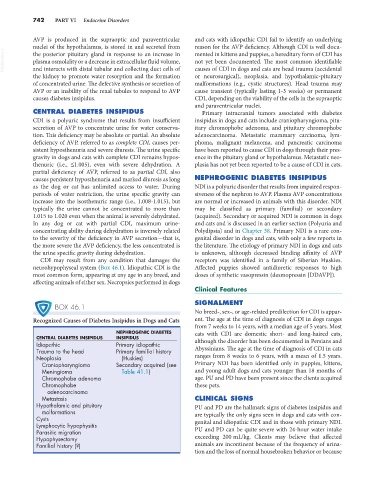Page 770 - Small Animal Internal Medicine, 6th Edition
P. 770
742 PART VI Endocrine Disorders
AVP is produced in the supraoptic and paraventricular and cats with idiopathic CDI fail to identify an underlying
nuclei of the hypothalamus, is stored in and secreted from reason for the AVP deficiency. Although CDI is well docu-
VetBooks.ir the posterior pituitary gland in response to an increase in mented in kittens and puppies, a hereditary form of CDI has
not yet been documented. The most common identifiable
plasma osmolality or a decrease in extracellular fluid volume,
and interacts with distal tubular and collecting duct cells of
or neurosurgical), neoplasia, and hypothalamic-pituitary
the kidney to promote water resorption and the formation causes of CDI in dogs and cats are head trauma (accidental
of concentrated urine. The defective synthesis or secretion of malformations (e.g., cystic structures). Head trauma may
AVP or an inability of the renal tubules to respond to AVP cause transient (typically lasting 1-3 weeks) or permanent
causes diabetes insipidus. CDI, depending on the viability of the cells in the supraoptic
and paraventricular nuclei.
CENTRAL DIABETES INSIPIDUS Primary intracranial tumors associated with diabetes
CDI is a polyuric syndrome that results from insufficient insipidus in dogs and cats include craniopharyngioma, pitu-
secretion of AVP to concentrate urine for water conserva- itary chromophobe adenoma, and pituitary chromophobe
tion. This deficiency may be absolute or partial. An absolute adenocarcinoma. Metastatic mammary carcinoma, lym-
deficiency of AVP, referred to as complete CDI, causes per- phoma, malignant melanoma, and pancreatic carcinoma
sistent hyposthenuria and severe diuresis. The urine specific have been reported to cause CDI in dogs through their pres-
gravity in dogs and cats with complete CDI remains hypos- ence in the pituitary gland or hypothalamus. Metastatic neo-
thenuric (i.e., ≤1.005), even with severe dehydration. A plasia has not yet been reported to be a cause of CDI in cats.
partial deficiency of AVP, referred to as partial CDI, also
causes persistent hyposthenuria and marked diuresis as long NEPHROGENIC DIABETES INSIPIDUS
as the dog or cat has unlimited access to water. During NDI is a polyuric disorder that results from impaired respon-
periods of water restriction, the urine specific gravity can siveness of the nephron to AVP. Plasma AVP concentrations
increase into the isosthenuric range (i.e., 1.008-1.015), but are normal or increased in animals with this disorder. NDI
typically the urine cannot be concentrated to more than may be classified as primary (familial) or secondary
1.015 to 1.020 even when the animal is severely dehydrated. (acquired). Secondary or acquired NDI is common in dogs
In any dog or cat with partial CDI, maximum urine- and cats and is discussed in an earlier section (Polyuria and
concentrating ability during dehydration is inversely related Polydipsia) and in Chapter 38. Primary NDI is a rare con-
to the severity of the deficiency in AVP secretion—that is, genital disorder in dogs and cats, with only a few reports in
the more severe the AVP deficiency, the less concentrated is the literature. The etiology of primary NDI in dogs and cats
the urine specific gravity during dehydration. is unknown, although decreased binding affinity of AVP
CDI may result from any condition that damages the receptors was identified in a family of Siberian Huskies.
neurohypophyseal system (Box 46.1). Idiopathic CDI is the Affected puppies showed antidiuretic responses to high
most common form, appearing at any age in any breed, and doses of synthetic vasopressin (desmopressin [DDAVP]).
affecting animals of either sex. Necropsies performed in dogs
Clinical Features
SIGNALMENT
BOX 46.1
No breed-, sex-, or age-related predilection for CDI is appar-
Recognized Causes of Diabetes Insipidus in Dogs and Cats ent. The age at the time of diagnosis of CDI in dogs ranges
from 7 weeks to 14 years, with a median age of 5 years. Most
NEPHROGENIC DIABETES cats with CDI are domestic short- and long-haired cats,
CENTRAL DIABETES INSIPIDUS INSIPIDUS although the disorder has been documented in Persians and
Idiopathic Primary idiopathic
Trauma to the head Primary familial history Abyssinians. The age at the time of diagnosis of CDI in cats
Neoplasia (Huskies) ranges from 8 weeks to 6 years, with a mean of 1.5 years.
Craniopharyngioma Secondary acquired (see Primary NDI has been identified only in puppies, kittens,
Meningioma Table 41.1) and young adult dogs and cats younger than 18 months of
Chromophobe adenoma age. PU and PD have been present since the clients acquired
Chromophobe these pets.
adenocarcinoma
Metastasis CLINICAL SIGNS
Hypothalamic and pituitary PU and PD are the hallmark signs of diabetes insipidus and
malformations are typically the only signs seen in dogs and cats with con-
Cysts
Lymphocytic hypophysitis genital and idiopathic CDI and in those with primary NDI.
Parasitic migration PU and PD can be quite severe with 24-hour water intake
Hypophysectomy exceeding 200 mL/kg. Clients may believe that affected
Familial history (?) animals are incontinent because of the frequency of urina-
tion and the loss of normal housebroken behavior or because

